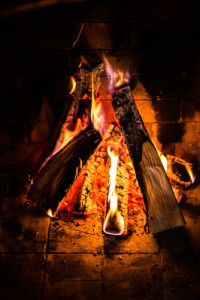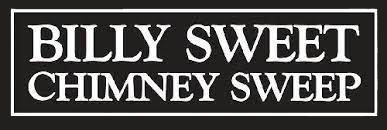by Billy Sweet | Jan 24, 2017 | Winter Fireplace
This winter you want to enjoy your fireplace. It is there on the cool nights for an evening of relaxation, entertaining, or warm your living space. If you don’t have a gas fireplace, odds are you might struggle to light a fire on a cold evening. A cold chimney makes it difficult to light a fire because the chimney is filled with cold air. This air can do two things:
- It can fall into your fireplace (and into your room) when you open the damper to vent your fire.
- It can block the smoke and exhaust from rising up the chimney.
The Problem
When your chimney is filled with cold air, smoke won’t rise up the chimney. This is because a new, small fire isn’t hot enough to push up the chimney. This can cause the harmful vapors and smoke to move into your living space.
The Solution
There are a couple of ways homeowners can make lighting a fire in a cold fireplace easier. Some homeowners decide to open the damper and allow the cold air in the chimney to fall into the fireplace. This option is especially viable if you have a central heating system in your home, because it won’t affect the overall heat. You should remember there are several cubic feet of frigid air in the chimney, and if the fireplace is your source of heat for the room, you will definitely add to the cold by using this method.
A Better Solution—Priming the Chimney
In order to prepare the chimney for the job of venting, the fire’s exhaust you can warm it slowly. First, find the opening from the fireplace or stove that leads to the chimney. Light a rolled newspaper, or roll of paper scraps, and hold it in the opening until it is completely finished burning. This small amount of heat can rise up, warming the air slowly. This prevents large amounts of smoke to move into your house. By the time the paper is finished burning, your chimney should be primed to vent your fire.
The Best Fire
The Chimney Safety Institute (CSIA) top-down burn over the traditional fire in all situations, including a cold fireplace. The top-down burn is opposite the tradition fire, in that the large logs are on the bottom, followed by medium, then smaller sticks, and kindling at the top. This way the fire, embers, and ash fall, letting gravity keep the fire going, burning all the fuel completely, and offering a cleaner burn and a more efficient fire. It is also easier to light a fire if you use properly seasoned wood when lighting and a using your fireplace.
For more information about your fireplace and how to operate it better with every burn, click here. You can also call a professional anytime between 7am and 5pm, Monday through Friday. Call 617-469-4528 today.
by Billy Sweet | Aug 24, 2016 | Winter Fireplace
It is late summer, and fall weather will start bringing cool temperatures with it soon! Now is the time to begin thinking about your home heating. There are numerous options to heat your home including central heat, wood and gas appliances, and a wood fireplace. Each of these options has benefits and drawbacks, and each home and family has specific needs and wishes to consider as well. While you are researching options and making decisions that will affect your energy bill, your comfort, and your decor, there are four things to keep in mind.
with it soon! Now is the time to begin thinking about your home heating. There are numerous options to heat your home including central heat, wood and gas appliances, and a wood fireplace. Each of these options has benefits and drawbacks, and each home and family has specific needs and wishes to consider as well. While you are researching options and making decisions that will affect your energy bill, your comfort, and your decor, there are four things to keep in mind.
Fuel
Appliances are designed to burn a specific kind of fuel. If you decide to use a pellet stove, you should only use a manufactured pellet product designed for that appliance. If you are using a wood fireplace or stove, you should use only properly seasoned wood. If you use a gas appliance or insert, you should have an existing natural gas hook-up, or have one professionally installed.
Ventilation
Depending on what kind of heat appliance you decide to use this winter, you may be able to use the existing chimney, or even avoid using one at all. Vent-free fireplace inserts don’t require chimney ventilation. Other inserts that do require ventilation don’t necessarily have to use the chimney. Your technician can actually use an alternate route during installation. Keep in mind that you can use your stainless steel flue liner for all fuel types. However, if you have a tile or cast liner, you will need to convert to an appropriate flue liner before using your appliance.
Cost
When choosing your new heat appliance for your home, don’t only think of the cost to buy and install it. Consider the energy cost over the winter as well as the routine maintenance. Some appliances are extremely low maintenance, like vent-free gas inserts. Others should be cleaned of ashes and soot, as well as require routine chimney sweeps and inspections regularly. The energy cost is also a deciding factor. Wood should be bought or chopped. Gas is purchased from an energy company. If the price of gas is exceptionally high, and you have readily accessibly trees and a chainsaw, wood may be the best option for your home right now, but if you live in an urban area and simply want the ambiance of a fire, gas would be for you. Finally, efficiency affects overall price as well. Gas appliances tend to be more efficient than wood. Keeping up with chimney maintenance also raises efficiency of your appliances. You may spend more upon purchase and installation, and save over the life of the furnace.
Aesthetics
If your home is a rustic cabin, you probably wouldn’t want a sleek, stainless-steel-framed gas insert. Likewise, if the goal is high-tech and hands off, you might like a gas insert with a simple switch to turn it on and off. Many of the appliances that Billy Sweet recommends and installs are available in various models to fit with the aesthetics of the home.
Are you dreading winter because you can’t choose which heat appliance you’d like to use? Billy Sweet Chimney Sweeps offers only the industry’s best stoves, fireplaces, and inserts. Our certified chimney sweeps are experienced and trained in installation and maintenance of all of our appliances. Don’t wait until it’s too cold! Call today to discuss your home heating options with a Billy Sweet chimney sweep.
by Billy Sweet | Oct 12, 2015 | Winter Fireplace
There is nothing quite like the first cold snap to send us all unpacking our winter clothes and grabbing the blankets out of the attic. Preparing yourself mentally is the first step, taking the proper precautions to prepare your fireplace for the upcoming season is another. Getting it ready now will save you the hassle and pain of dealing with it when there are several feet of snow outside!

The first step is the biggest:
Getting your fireplace professionally inspected and swept by our CSIA-certified sweeps will not only make sure that your fireplace is in the best shape possible to combat the degrading snow and water, as well as the smoke buildup that comes with use. The buildup, called creosote, is highly flammable, and could result in a chimney fire if you’re not careful. We not only clean the creosote off the inside of your chimney, we check for any loose or missing mortar so that your chimney is in tip-top shape before it takes on the winter.
Spic and span:
We want to inspect and sweep your chimney fireplace annually, but it is imperative that you do your part in keeping your fireplace clean as well. Disposing of the majority of ash and burnt timber in a wood-burning firebox will not only look more aesthetically pleasing and leave you more space for logs, but the chances of a flying ember catching your carpet on fire becomes a lot more slim. Just gently shovel the cooled ash into a bucket and dispose of it in the trash.
Putting a damper on it:
Your damper controls airflow in and out of your chimney. Check your damper for ease of use, making sure it opens and closes with no struggle. If the damper doesn’t close properly, there will be a cold draft that comes into the room when the fireplace isn’t in use. If the damper is hard to open, proper ventilation could keep carbon monoxide from exiting out the chimney, instead filling your room with the deadly chemical.
Fires of all kinds:
Weather you have a wood-burning fireplace or a gas stove, it is important to have enough fuel to keep you and your family warm for at least three days. Keep it in an easily accessible in case of a power outage. Also, make sure you have a supply of firefighting materials such as a fire extinguisher, a bucket of water, or baking soda readily available in case a fire gets out of hand or some buildup catches fire. Again, it’s always better to be over prepared.
Knowing that your fireplace and chimney are taken care of will give you peace of mind while the wind whistles through the trees outside. It’s not too late to schedule your annual inspection and sweeping. Call Billy Sweet Chimney Sweep today!

 with it soon! Now is the time to begin thinking about your home heating. There are numerous options to heat your home including central heat, wood and gas appliances, and a wood fireplace. Each of these options has benefits and drawbacks, and each home and family has specific needs and wishes to consider as well. While you are researching options and making decisions that will affect your energy bill, your comfort, and your decor, there are four things to keep in mind.
with it soon! Now is the time to begin thinking about your home heating. There are numerous options to heat your home including central heat, wood and gas appliances, and a wood fireplace. Each of these options has benefits and drawbacks, and each home and family has specific needs and wishes to consider as well. While you are researching options and making decisions that will affect your energy bill, your comfort, and your decor, there are four things to keep in mind.